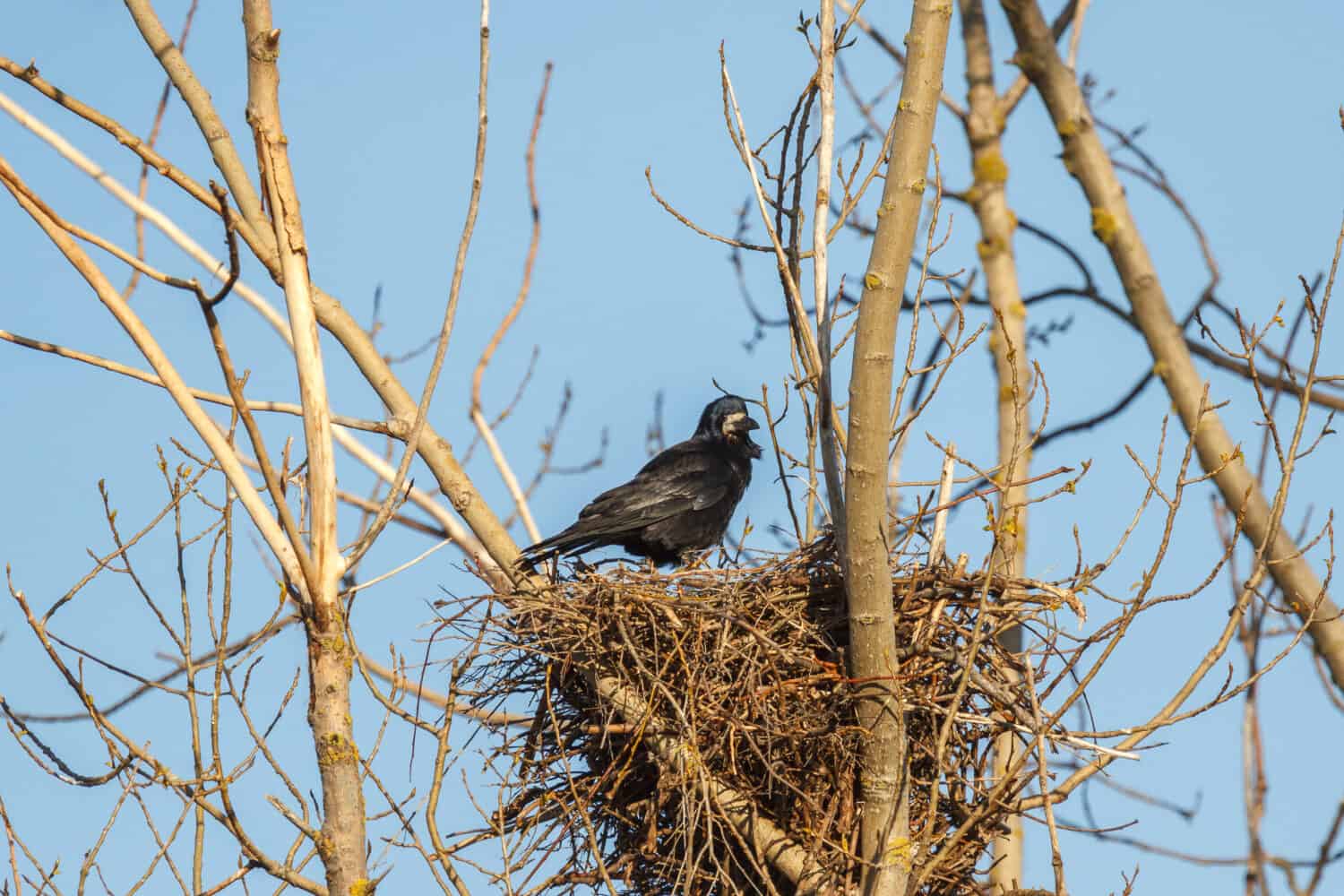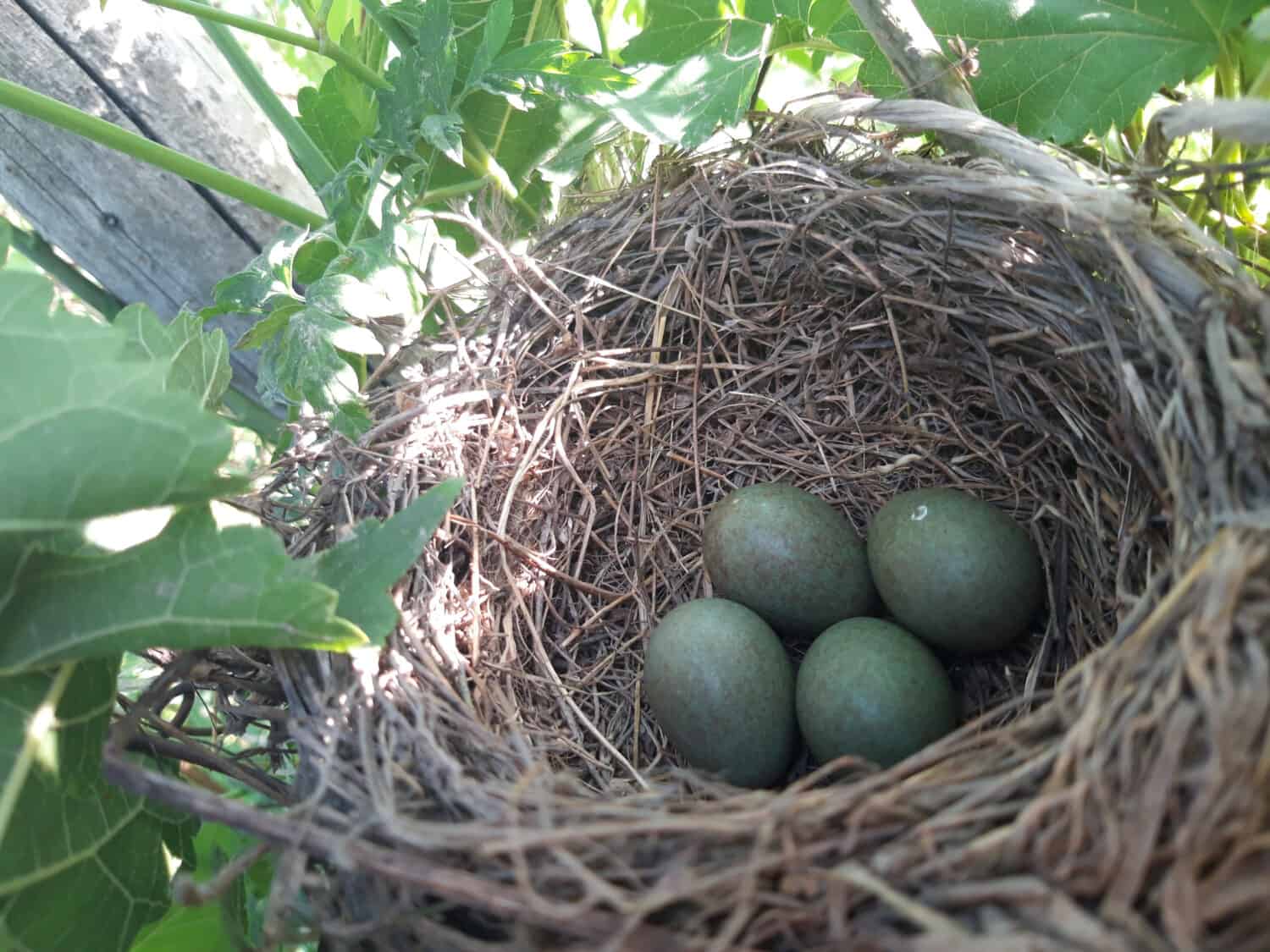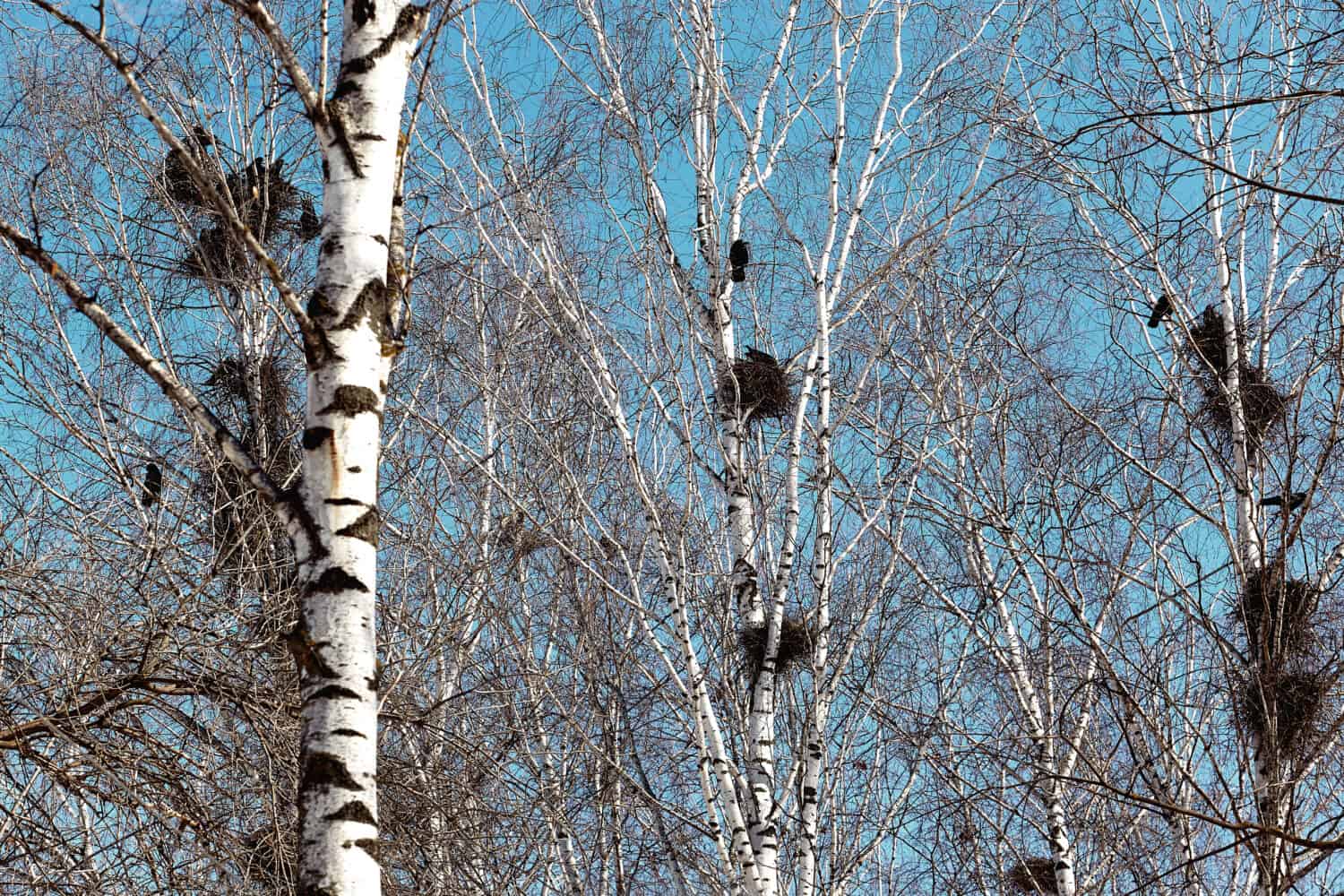With their ebony plumage and clever demeanor, the mystique surrounding crows has fascinated both avid bird watchers and casual observers for generations. One fascinating aspect of these avian creatures is their choice of nesting sites. Let’s unravel the enigma of crow nesting habits from the specific types of trees they favor and the heights at which they construct their nests to their challenges, adaptations, and interactions with humans.

Crows have their preferences for trees but are also adaptable.
©iStock.com/Karel Bock
Tree Selection for Nesting Locations
Crows, with their discerning nature, exhibit particular preferences when it comes to selecting their nests. Crows can be adaptable when choosing locations if it’s in their selected adaptable tree species. While they typically favor tall structures or the upper canopy of trees as nesting sites, they are not particularly selective and will nest in any safe place. Regarding tree selection, they will assess the area for potential nesting locations and the type of tree that best suits their needs. They prefer to be up around 60 feet above the ground.
Deciduous Trees
You can spot crows in deciduous trees, such as oaks, maples, beeches, and birches, as their preferred locations. These trees provide sturdy branches and dense foliage, protecting against predators. The rich diversity of deciduous forests offers ample opportunities for crows to find suitable nesting sites.
Coniferous Trees
Crows often select coniferous trees, such as pines and spruces, for their nesting sites. This is because the year-round foliage of these trees provides extra protection and shelter, especially in harsh weather. Crows use these trees to build their nests when living in areas where coniferous forests are typical.
Urban Habitats
Crows are highly adaptable and can utilize man-made structures within urban environments as nesting sites. Their resourcefulness in adapting to urban landscapes highlights their ability to find suitable nesting opportunities even in non-traditional settings. Telephone poles, buildings, and streetlights are among the structures that crows may select to build their nests.

Crows are intelligent and have strategies to protect their nest from predators.
©LFRabanedo/Shutterstock.com
Nesting Challenges and Adaptations
The nesting journey of crows is not without its share of challenges. However, these highly adaptable birds have developed remarkable strategies and adaptations to overcome these obstacles.
Predator Deterrence: Protecting the Nest
Crows employ various strategies to protect their nests from predators. When a predator approaches, crows engage in mobbing behavior, where multiple crows gather and collectively confront the intruder. This mobbing behavior not only helps to intimidate predators but also alerts other nearby animals to the potential threat.
Crows also emit vocal alarms, producing loud caws that serve as warning signals to other members of the crow community. Crows may even physically attack potential threats, dive-bombing and pecking at them to drive them away from the nest. These sophisticated predator-deterrence strategies showcase the crows’ social intelligence and cooperative nature.

Squirrels are one of the common predators of a crow nest.
©Tomasz Budzynski/Shutterstock.com
Common Predators of Crow Nests
Some common predators that impact a nest can include:
Hawks and Owls
These birds of prey often target both eggs and young crows. Hawks and owls use their sharp talons to pluck crows from the nest or snatch them up as they take flight.
Mammals
Mammals such as raccoons, cats, and opossums can majorly threaten a crow nest. They may sneak into the nest, steal eggs, or take young crows away.
Snakes
Some snakes, like the rat and king snakes, may climb into a crow nest to feast on eggs.
Humans
Sadly, humans can sometimes harm crow nests by taking eggs for their own collections. Additionally, some people may destroy crow nests to avoid conflicts with the crows.
Nest Parasites
Certain species, like the brown-headed cowbird, are notorious for laying their eggs in crow nests. Crows have developed strategies to handle this intrusion when a cowbird egg is detected in its nest. They may remove the cowbird eggs from the nest by picking them up, carrying them away, or pushing them out. If the number of cowbird eggs becomes excessive, crows may abandon the nest and build a new one elsewhere.
The presence of cowbird eggs can impact nesting success, as the cowbird chicks may outcompete the crow chicks for resources. Crows’ ability to recognize and respond to these nest parasites demonstrates their adaptability and resourcefulness in maintaining the success of their own brood.

A female crow lays about three to six eggs at a time.
©Genc Subhan/Shutterstock.com
Nesting Season and Reproductive Cycle
Gaining knowledge about the nesting season and reproductive cycle can provide important information about their behavior and the complex relationships within crow families.
Egg-Laying and Incubation
The nesting season typically occurs from mid-March to mid-July; however, it depends on the geographic location. Female crows carefully select a suitable site within their chosen tree and construct a nest made of twigs, leaves, and other materials. Once the nest is prepared, the female lays a clutch of eggs, usually three to six.
The female is primarily responsible for incubating the eggs, using her body heat to maintain the eggs’ temperature and humidity. However, the male also participates, taking turns to provide warmth and protection during the incubation period, lasting about 18 to 20 days.
Nestling Development
Once the eggs hatch, the nestling phase begins. The parents diligently care for their hatchlings, providing nourishment through regurgitated food. They feed the nestlings a varied diet, including insects, small vertebrates, fruits, and seeds, ensuring their nutritional needs are met. The nestlings grow rapidly under the attentive care of their parents. The parents monitor their development throughout this period, providing warmth, protection, and guidance. The nestling typically lasts about 4 to 5 weeks, after which the young crows become fledglings, ready to explore the world beyond the nest.

Crows are adaptable to various environments.
©Drovnin/Shutterstock.com
Nesting Sites and Climate Considerations: Adapting to Varied Landscapes
A crow’s preference for nesting reflects the unique characteristics of each region. In warmer areas, crows may select sites in trees with denser foliage to provide shade and protection from the heat. In colder areas, they may choose nesting sites in trees that offer better insulation against the cold weather.
Furthermore, crows in coastal areas tend to choose sites nearer to the water sources, whereas those in wooded regions prefer to nest in areas sheltered by thick vegetation. These differences in site selection suggest that crows can adapt to their environment and maximize their chances of successful nesting.
Nesting Success Factors: The Key to Thriving Nests
The success depends on various factors, including the nest’s location. Nests that are in well-hidden locations are more likely to be successful. The tree cover and nearby plants help to hide the nest from predators and decrease the chances of detection.
The presence of conspecific neighbors can also contribute to nesting success, as neighboring crows may engage in cooperative defense against predators, enhancing overall nest survival. Additionally, the availability of sufficient food resources and favorable weather conditions during the nesting period further improve the chances of successful reproduction.
Human Interactions and Crow Nesting: A Delicate Balance
Human activities, such as deforestation, urbanization, and nest destruction, can disrupt and endanger sites. Deforestation reduces the availability of suitable nesting trees and disrupts established crow territories. Urbanization presents its challenges, with increased noise pollution, artificial lighting, and reduced access to natural resources. Nest destruction, whether intentional or unintentional, further threatens crow populations. We must be mindful of these impacts and minimize site disturbance to ensure their continued survival.
When Are American Crows Most Active?
The American crows are generally active during the day. However, they are particularly active during the early morning and late afternoon when they search for food.
American crows can be found in every US state, including Texas, where they are permanent residents. They are also found throughout North America, from Alaska to Panama.
Conclusion
Crows demonstrate intelligence and resourcefulness in protecting their offspring. They carefully choose tree species and nest heights and are skilled at deterring predators and dealing with parasites. By studying their nesting season, regional differences, and adaptation to urban environments, we can gain valuable insights into their ability to survive and thrive in various landscapes.
The photo featured at the top of this post is © Moisieiev Igor/Shutterstock.com
Thank you for reading! Have some feedback for us? Contact the AZ Animals editorial team.






